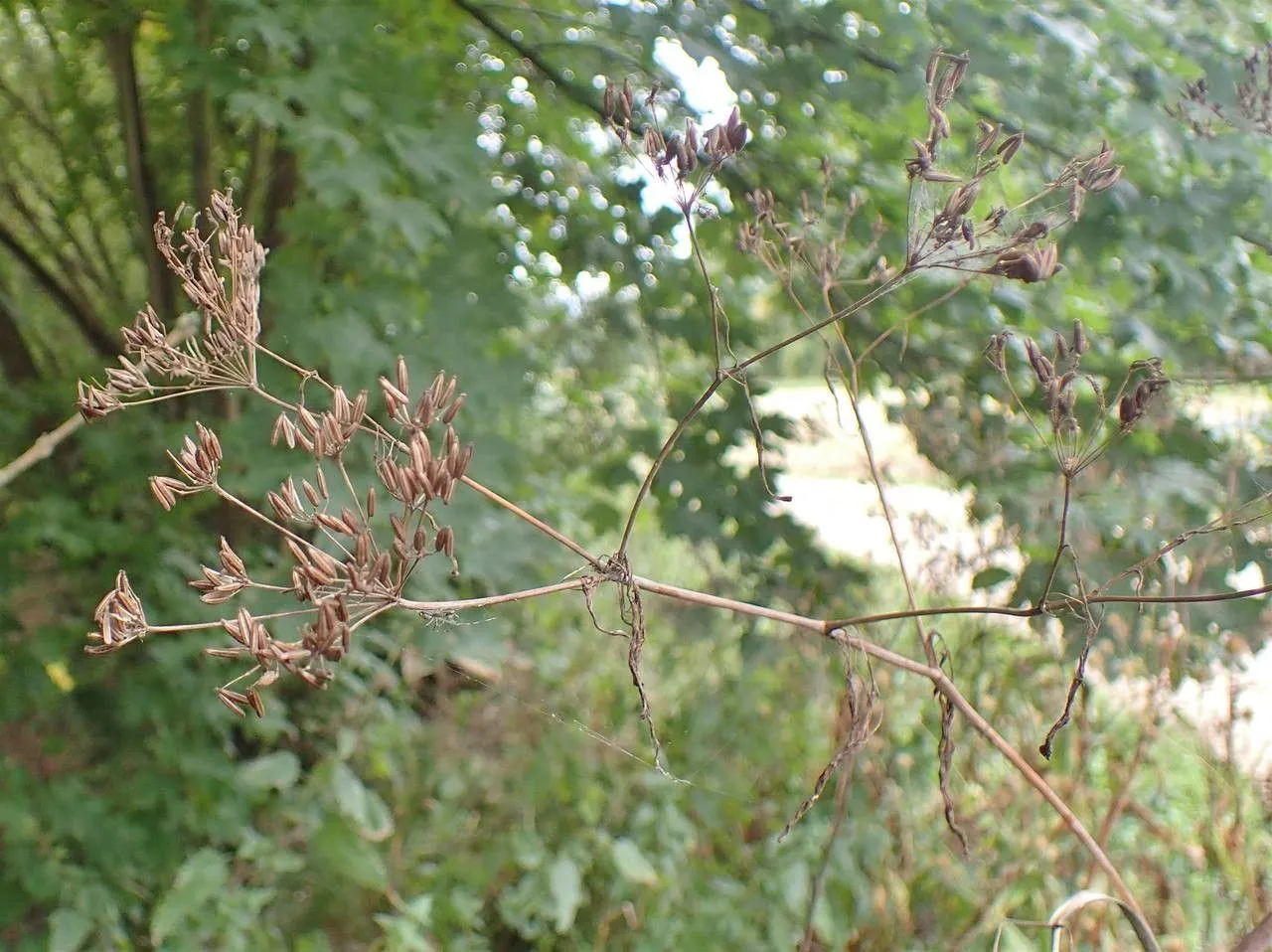
Author: L.
Bibliography: Sp. Pl.: 258 (1753)
Year: 1753
Status: accepted
Rank: species
Genus: Chaerophyllum
Vegetable: False
Observations: Europe to N. Türkiye and C. Asia
Turnip-root chervil, scientifically known as Chaerophyllum bulbosum, is an intriguing and lesser-known plant that belongs to the Apiaceae family. This hardy biennial plant, first described by the renowned botanist Carl Linnaeus in 1753, flourishes across a broad range of regions, spanning from Europe to Northern Türkiye and Central Asia.
Characterized by its uniquely bulbous root, turnip-root chervil is not only valued for its distinctive culinary potential but also for its ornamental appeal. The plant boasts finely divided, fern-like leaves that contribute to its graceful appearance, a common trait within the Apiaceae family. During its growth cycle, it produces delicate white umbels of flowers, which attract a multitude of pollinators.
What primarily sets turnip-root chervil apart is its edible root, which resembles a small turnip. Known for its subtly sweet and nutty flavor, this root can be used similarly to other root vegetables in a variety of culinary preparations, offering a unique twist to traditional dishes. It can be steamed, roasted, or added to stews and soups, where it imparts a pleasant and distinct taste.
Beyond its culinary uses, turnip-root chervil has also sparked interest for its potential health benefits. Like many members of the Apiaceae family, it contains essential nutrients and has been historically used in folk medicine to promote digestive health and overall well-being.
Growing Chaerophyllum bulbosum in the garden requires a bit of patience, as it is a biennial plant. Typically, it establishes its root system in the first year and flowers in the second. It thrives best in a well-drained soil with moderate moisture and prefers a sunny to partially shaded location. Gardeners appreciate its resilience and relatively low-maintenance nature, which, in addition to its aesthetic and culinary value, makes it a worthy addition to both ornamental and edible gardens.
Whether you are drawn to its distinctive root’s culinary possibilities or its graceful presence in a garden setting, turnip-root chervil is a plant that offers much more than meets the eye. Its spread from Europe to Türkiye and across Central Asia points to its adaptability and longstanding value across various cultures and landscapes.
Swe: bitterskråp, doftskråp, pestskråp, ulltistel, rotkörvel, knölfloka, körvelrova
Ita: cerfoglio bulboso
Nor: eseltistel, japanpestrot, lækjepestrot
Fin: etelänruttojuuri, japaninruttojuuri, kruunuohdake
Lit: gumbuotasis gurgždis
Dan: japanpestrot, knoldet hulsvøb, rød hestehov, æselfoder
Deu: kerbelrübe, knollenkerbel, knollenkälberkropf, knolliger kälberkropf, rüben-kälberkropf, rübenkerbel
Eng: turnip-root chervil, bulbous chervil, parsnip chervil, tuberous chervil
Por: batata-cenoura, batata-salsa, perjil
Lav: bumbuļu k
Fra: cerfeuil bulbeux, cerfeuil à bulbe
Nld: knolribzaad
Est: mugul-varesputk
Spa: perifollo bulboso
Sme: ruoššagearvil
En: Turnip-root chervil, Bulbous chervil, Parsnip chervil, Tuberous chervil, Tuberous-rooted Chervil
Ar: سرفل بصيلي
Hy: Շուշանաբանջար սոխուկավոր
Be: Цьмянец клубняносны
Bg: Грудков балдаран
Cs: Krabilice hlíznatá
Da: Japanpestrot, Knoldet hulsvøb, Rød Hestehov, Æselfoder
Nl: Knolribzaad, Knolkervel
Eo: Tubera kerofilo
Et: Mugul-varesputk
Fi: Mukulakirveli, Etelänruttojuuri, Japaninruttojuuri, Kruunuohdake
Fr: Cerfeuil bulbeux, “Cerfeuil bulbeux, Cerfeuil à bulbe”, Cerfeuil à bulbe, Chérophylle bulbeux
De: Knollenkerbel, Rübenkerbel, Kerbelrübe, Knollen-Kälberkropf, Knollenkälberkropf, Rüben-Kälberkropf, Knolliger Kälberkropf
It: Cerfoglio bulboso
Lv: Bumbuļu k
Lt: Gumbuotasis gurgždis
Se: Ruoššagearvil
No: Eseltistel, Japanpestrot, Lækjepestrot
Pl: Świerząbek bulwiasty
Pt: Perjil, Batata-cenoura, Batata-salsa
Ro: Baraboi (plantă)
Ru: Бутень клубненосный
Sk: Krkoška hľuznatá
Es: Perifollo bulboso
Sv: Rotkörvel, Bitterskråp, Doftskråp, Pestskråp, Ulltistel, Knölfloka, Körvelrova
Taken Jul 28, 2022 by Annett Franke (cc-by-sa)
Taken Sep 6, 2015 by Tela Botanica − Yoan MARTIN (cc-by-sa)
Taken Jul 23, 2011 by Tela Botanica − Florent Beck (cc-by-sa)
Taken Sep 9, 2017 by Yoan MARTIN (cc-by-sa)
Taken Sep 9, 2017 by Yoan MARTIN (cc-by-sa)
Taken Sep 9, 2017 by Yoan MARTIN (cc-by-sa)
Taken Aug 10, 2022 by Andrzej Konstantynowicz (cc-by-sa)
Taken Jun 10, 2022 by Kai Best (cc-by-sa)
Taken Jun 22, 2021 by santepIab (cc-by-sa)
Taken Jul 23, 2011 by Tela Botanica − Florent Beck (cc-by-sa)
Taken Aug 10, 2022 by Andrzej Konstantynowicz (cc-by-sa)
Taken Jun 20, 2022 by Kate (cc-by-sa)
Taken Jul 23, 2011 by Tela Botanica − Florent Beck (cc-by-sa)
Taken Jul 3, 2022 by Smilla P (cc-by-sa)
Taken Jun 18, 2021 by Pfannkuchen Deluxe (cc-by-sa)
Taken Sep 9, 2017 by Yoan MARTIN (cc-by-sa)
Taken Sep 9, 2017 by Yoan MARTIN (cc-by-sa)
Taken Sep 9, 2017 by Yoan MARTIN (cc-by-sa)
Taken Jul 23, 2011 by Tela Botanica − Florent Beck (cc-by-sa)
Taken Jul 3, 2022 by Smilla P (cc-by-sa)
© copyright of the Board of Trustees of the Royal Botanic Gardens, Kew.
Taken Jun 22, 2021 by santepIab (cc-by-sa)
Taken Jul 16, 2022 by Alexander Baransky (cc-by-sa)
Taken Nov 3, 2016 by Yoan MARTIN (cc-by-sa)
Taken Nov 3, 2016 by Yoan MARTIN (cc-by-sa)
Taken Jun 20, 2022 by Kate (cc-by-sa)
Taken Jul 23, 2011 by Tela Botanica − Florent Beck (cc-by-sa)
Taken Jul 23, 2011 by Tela Botanica − Florent Beck (cc-by-sa)
Taken Jul 1, 2021 by Liane Bienert (cc-by-sa)
Taken Jul 3, 2022 by Smilla P (cc-by-sa)
Taken Jan 14, 2021 by Kurtuluş Turgay (cc-by-sa)
Growth habit: Forb/herb
Ph maximum: 8.0
Ph minimum: 7.5
Light: 7
Atmospheric humidity: 6
Bloom months: [‘jun’, ‘jul’]
Soil nutriments: 8
Family: Myrtaceae Author: (F.Muell.) K.D.Hill & L.A.S.Johnson Bibliography: Telopea 6: 402 (1995) Year: 1995 Status:…
Family: Rubiaceae Author: Pierre ex A.Froehner Bibliography: Notizbl. Bot. Gart. Berlin-Dahlem 1: 237 (1897) Year:…
Family: Sapindaceae Author: Koidz. Bibliography: J. Coll. Sci. Imp. Univ. Tokyo 32(1): 38 (1911) Year:…
Family: Asteraceae Author: A.Gray Bibliography: Pacif. Railr. Rep.: 107 (1857) Year: 1857 Status: accepted Rank:…
Family: Fabaceae Author: Medik. Bibliography: Vorles. Churpfälz. Phys.-Ökon. Ges. 2: 398 (1787) Year: 1787 Status:…
Family: Aspleniaceae Author: (Cav.) Alston Bibliography: Bull. Misc. Inform. Kew 1932: 309 (1932) Year: 1932…